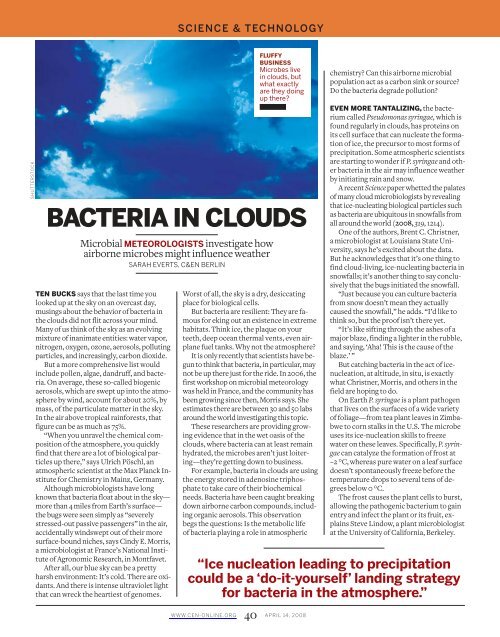Chemical & Engineering News Digital Edition - Institute of Materia ...
Chemical & Engineering News Digital Edition - Institute of Materia ...
Chemical & Engineering News Digital Edition - Institute of Materia ...
Create successful ePaper yourself
Turn your PDF publications into a flip-book with our unique Google optimized e-Paper software.
SHUTTERSTOCK<br />
TEN BUCKS says that the last time you<br />
looked up at the sky on an overcast day,<br />
musings about the behavior <strong>of</strong> bacteria in<br />
the clouds did not flit across your mind.<br />
Many <strong>of</strong> us think <strong>of</strong> the sky as an evolving<br />
mixture <strong>of</strong> inanimate entities: water vapor,<br />
nitrogen, oxygen, ozone, aerosols, polluting<br />
particles, and increasingly, carbon dioxide.<br />
But a more comprehensive list would<br />
include pollen, algae, dandruff, and bacteria.<br />
On average, these so-called biogenic<br />
aerosols, which are swept up into the atmosphere<br />
by wind, account for about 20%, by<br />
mass, <strong>of</strong> the particulate matter in the sky.<br />
In the air above tropical rainforests, that<br />
figure can be as much as 75%.<br />
“When you unravel the chemical composition<br />
<strong>of</strong> the atmosphere, you quickly<br />
find that there are a lot <strong>of</strong> biological particles<br />
up there,” says Ulrich Pöschl, an<br />
atmospheric scientist at the Max Planck <strong>Institute</strong><br />
for Chemistry in Mainz, Germany.<br />
Although microbiologists have long<br />
known that bacteria float about in the sky—<br />
more than 4 miles from Earth’s surface—<br />
the bugs were seen simply as “severely<br />
stressed-out passive passengers” in the air,<br />
accidentally windswept out <strong>of</strong> their more<br />
surface-bound niches, says Cindy E. Morris,<br />
a microbiologist at France’s National <strong>Institute</strong><br />
<strong>of</strong> Agronomic Research, in Montfavet.<br />
After all, our blue sky can be a pretty<br />
harsh environment: It’s cold. There are oxidants.<br />
And there is intense ultraviolet light<br />
that can wreck the heartiest <strong>of</strong> genomes.<br />
SCIENCE & TECHNOLOGY<br />
BACTERIA IN CLOUDS<br />
Microbial METEOROLOGISTS investigate how<br />
airborne microbes might influence weather<br />
SARAH EVERTS, C&EN BERLIN<br />
FLUFFY<br />
BUSINESS<br />
Microbes live<br />
in clouds, but<br />
what exactly<br />
are they doing<br />
up there?<br />
Worst <strong>of</strong> all, the sky is a dry, desiccating<br />
place for biological cells.<br />
But bacteria are resilient: They are famous<br />
for eking out an existence in extreme<br />
habitats. Think ice, the plaque on your<br />
teeth, deep ocean thermal vents, even airplane<br />
fuel tanks. Why not the atmosphere?<br />
It is only recently that scientists have begun<br />
to think that bacteria, in particular, may<br />
not be up there just for the ride. In 2006, the<br />
first workshop on microbial meteorology<br />
was held in France, and the community has<br />
been growing since then, Morris says. She<br />
estimates there are between 30 and 50 labs<br />
around the world investigating this topic.<br />
These researchers are providing growing<br />
evidence that in the wet oasis <strong>of</strong> the<br />
clouds, where bacteria can at least remain<br />
hydrated, the microbes aren’t just loitering—they’re<br />
getting down to business.<br />
For example, bacteria in clouds are using<br />
the energy stored in adenosine triphosphate<br />
to take care <strong>of</strong> their biochemical<br />
needs. Bacteria have been caught breaking<br />
down airborne carbon compounds, including<br />
organic aerosols. This observation<br />
begs the questions: Is the metabolic life<br />
<strong>of</strong> bacteria playing a role in atmospheric<br />
WWW.CEN-ONLINE.ORG 40 APRIL 14, 2008<br />
chemistry? Can this airborne microbial<br />
population act as a carbon sink or source?<br />
Do the bacteria degrade pollution?<br />
EVEN MORE TANTALIZING, the bacterium<br />
called Pseudomonas syringae, which is<br />
found regularly in clouds, has proteins on<br />
its cell surface that can nucleate the formation<br />
<strong>of</strong> ice, the precursor to most forms <strong>of</strong><br />
precipitation. Some atmospheric scientists<br />
are starting to wonder if P. syringae and other<br />
bacteria in the air may influence weather<br />
by initiating rain and snow.<br />
A recent Science paper whetted the palates<br />
<strong>of</strong> many cloud microbiologists by revealing<br />
that ice-nucleating biological particles such<br />
as bacteria are ubiquitous in snowfalls from<br />
all around the world (2008, 319, 1214).<br />
One <strong>of</strong> the authors, Brent C. Christner,<br />
a microbiologist at Louisiana State University,<br />
says he’s excited about the data.<br />
But he acknowledges that it’s one thing to<br />
find cloud-living, ice-nucleating bacteria in<br />
snowfalls; it’s another thing to say conclusively<br />
that the bugs initiated the snowfall.<br />
“Just because you can culture bacteria<br />
from snow doesn’t mean they actually<br />
caused the snowfall,” he adds. “I’d like to<br />
think so, but the pro<strong>of</strong> isn’t there yet.<br />
“It’s like sifting through the ashes <strong>of</strong> a<br />
major blaze, finding a lighter in the rubble,<br />
and saying, ‘Aha! This is the cause <strong>of</strong> the<br />
blaze.’ ”<br />
But catching bacteria in the act <strong>of</strong> icenucleation,<br />
at altitude, in situ, is exactly<br />
what Christner, Morris, and others in the<br />
field are hoping to do.<br />
On Earth P. syringae is a plant pathogen<br />
that lives on the surfaces <strong>of</strong> a wide variety<br />
<strong>of</strong> foliage—from tea plant leaves in Zimbabwe<br />
to corn stalks in the U.S. The microbe<br />
uses its ice-nucleation skills to freeze<br />
water on these leaves. Specifically, P. syringae<br />
can catalyze the formation <strong>of</strong> frost at<br />
−2 °C, whereas pure water on a leaf surface<br />
doesn’t spontaneously freeze before the<br />
temperature drops to several tens <strong>of</strong> degrees<br />
below 0 °C.<br />
The frost causes the plant cells to burst,<br />
allowing the pathogenic bacterium to gain<br />
entry and infect the plant or its fruit, explains<br />
Steve Lindow, a plant microbiologist<br />
at the University <strong>of</strong> California, Berkeley.<br />
“Ice nucleation leading to precipitation<br />
could be a ‘do-it-yourself’ landing strategy<br />
for bacteria in the atmosphere.”

















